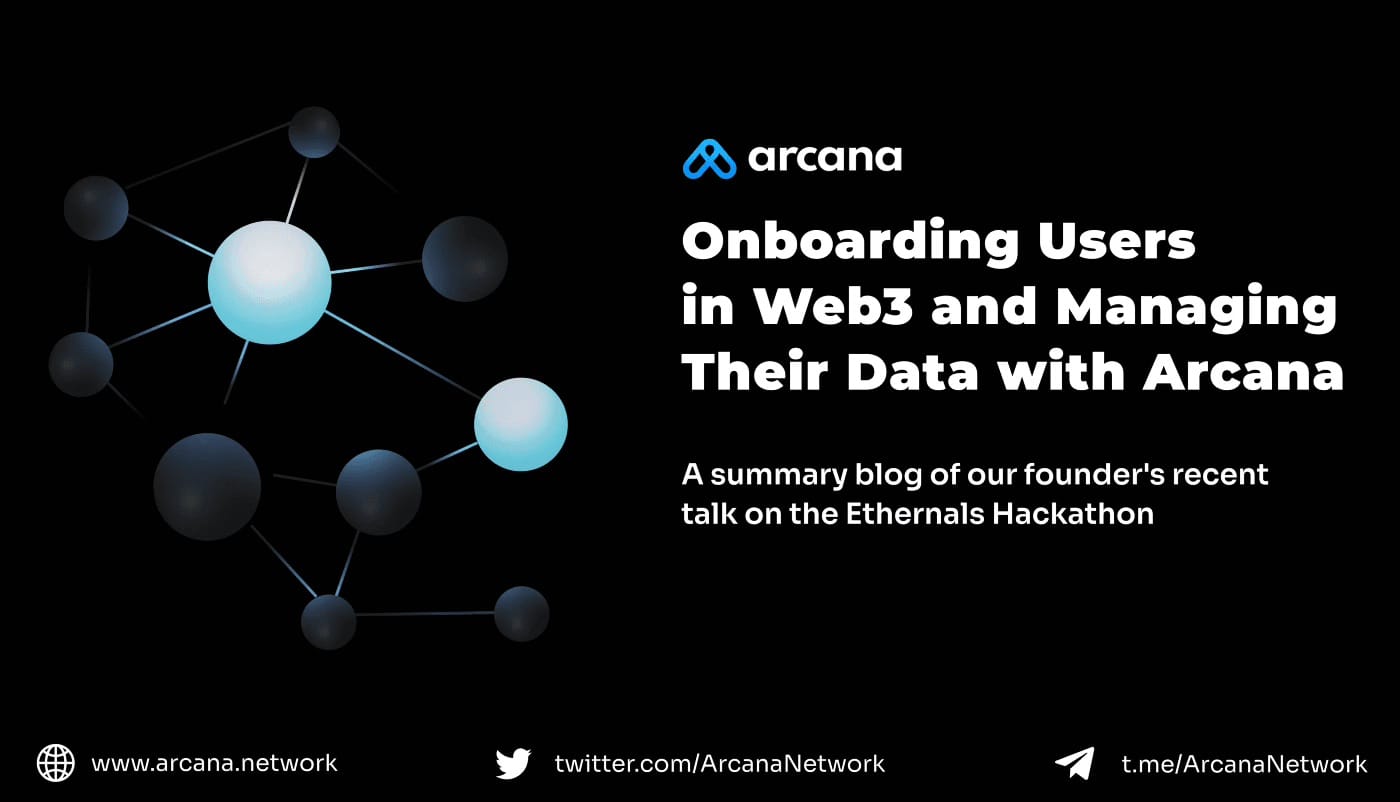Onboarding Users in Web3 and Managing their Data with Arcana
Onboard users and manage their data seamlessly in Web3 with Arcana Auth. Learn how in this informative blog post on our website.

This blogpost is a summary of our founder Mayur Relekar’s recent session in the Ethernals Hackathon. You can check out the full video of Mayur’s session on YouTube (link provided towards the end of the blog). For those of you who’d like a quick recap of what the session was about, read on.
Before we dive into what the session entailed, we’d first have to touch upon what Arcana offers. We at Arcana are building a decentralized storage platform along with a Privacy Stack. This session, in particular, is about a part of our privacy stack, known as Arcana Auth.
Arcana Auth
So exactly does Arcana Auth do and what problems does it solve? It helps tackle the three major problems involved with onboarding users to DApps, which are:
Nativity
This aspect deals with if the users of a particular DApp are tech native or not. Even if they are tech native, the problem may still persist if they are not Web3 native. Because there are cases where being tech native doesn’t translate to ease of use or comfort with Web3 Dapps.
Ease of Use
When it comes to the ease of use of any DApp, wallets are the major concern to deal with. If a DApp requires users to install a wallet, that in itself can be a point of friction. Because users may not always be comfortable with installing a new wallet, getting acquainted with it, and so forth. On top of that, if users are needed to manage their own keys or the seed phrase, there is a likelihood that it would discourage them from using a certain DApp in the first place.
Time
Time, in this context, is how long it takes for a user to start interacting with a DApp. If it takes long for users to get started with a DApp and use it, there is a strong chance of experiencing a high dropout rate.
Now that we have defined the three problems that are standing in the way of onboarding new users to DApps, we move on to three solutions that can be implemented to reduce friction and increase the rate at which users onboard. They are:
- Familiar Environment– so users feel right at home.
- Easy to Use– so there’s reduced friction and less dropout rate.
- Quick Access– to simplify onboarding and help users seamlessly interact with a DApp.
How Arcana Auth Fits into the Picture
Arcana Auth basically provides a no-nonsense, quick access to DApps. It does so by authenticating users using DApps through three modes:
- Passwordless — OTP-based logins are sent to the email address or phone number of users. This way, even non-tech savvy users can easily sign up and access DApps.
- Social Logins — Login through Google, Facebook, Reddit, Twitter, and so on. This is especially useful for Web2, internet natives who aren’t fully acquainted with Web3.
- BYOK– Bring your own keys; web3 natives who are already using MetaMask or WalletConnect can “bring their own keys.”
So whether a user is a non-tech savvy individual or a Web3 native, there is no stone unturned to make the authentication process seamless and friction-less.
What Arcana Auth Provides & How it Works
Arcana Auth, in essence, provides a public-private key pair on any EVM chain (Ethereum, Polygon, BSC). In the near future, we will support other chains as well. With the use of these private-public key pairs, users can access their wallets, sign transactions, and encrypt data.
We now move on to understanding how Arcana Auth works. Consider a user trying to authenticate themselves in a DApp using Google Auth (which is one of the go-to choices for most internet users). Here’s the sequence of events:
- Users sign up with Gmail, and the Google servers authenticate the email address.
- Once the above step is done, the Arcana DKG nodes learn of user authentication that has been completed on Google servers in the previous step.
- Now in the DKG nodes, each node will relay a unique “piece” of the encrypted private key of users.
- Now these “pieces” of encrypted private keys are sent back to the client (which is nothing but the DApp which has been using Arcana Auth).
After walking through the steps of how Arcana Auth works, Mayur went on to show a quick demo of how everything fits in together, followed by a round of Q&As before ending the session.
Check the full video of Mayur’s session in the Ethernals Hackathon👇
Want to know more about our latest testnet features? Book a demo.
Official Links: Website | Twitter | Discord| Telegram | TG Announcement | Medium | GitHub

